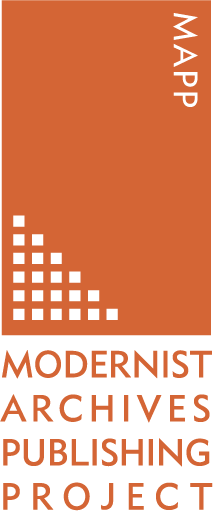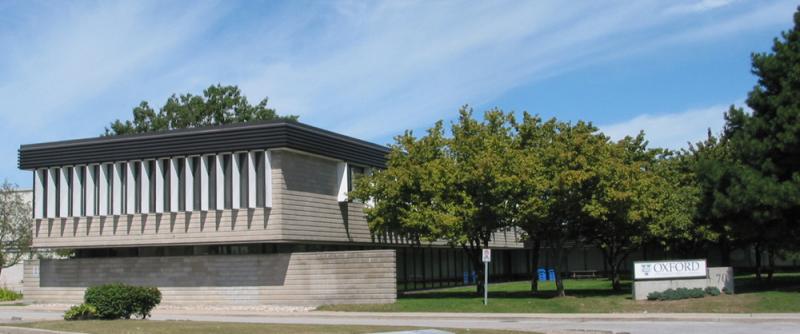Oxford University Press Canada
Description
Authored By: Ruth Panofsky
On 10 August 1904, when Oxford University Press (OUP) set up shop in the Clarendon building at 25 Richmond Street West in downtown Toronto – known among the trade as Booksellers Row – it joined a small but significant group of publishing houses already operating in the city. Eight years earlier, in September 1896, OUP had opened its first branch operation in New York. The founding of a second branch in Toronto, an emerging hub for Canada’s burgeoning publishing industry, served to widen OUP’s presence in North America.
Prior to the Second World War, most titles available in Canada were produced either in Britain or the United States and were shipped as plates, unbound sheets, or complete books to local agency or branch offices. Throughout OUP’s early years in Canada, Samuel Bradley Gundy, the first manager of the Toronto branch, oversaw the regular delivery of crates of books from overseas. Under Gundy, the company also published the first titles to carry the OUP Canada imprint: humourist Stephen Leacock’s Sunshine Sketches of a Little Town (1912) and poet Wilfred Campbell’s edited anthology The Oxford Book of Canadian Verse (1913). In 1929, Gundy also supervised the firm’s move to its own premises; Amen House at 480 University Avenue was a Tudor-style building designed specifically for OUP Canada by local architects Henry Sproatt and Ernest Rolph.
Following Gundy’s death in 1936, William Henry Clarke, a veteran of the publishing business, was appointed manager. It was Clarke’s good fortune to head OUP Canada during a period of revitalizing change in the publishing industry, when government advocacy of cultural industries fostered an interest in Canadian writing, and Canadian books sold in unprecedented numbers to a widening audience. Thus, Clarke’s list reflected an emerging taste for books about national identity, Canadian culture, and Canada’s role in world events. It included award-winning titles by prose writer/painter Emily Carr (Klee Wyck 1941), poet Robert Finch (Poems 1946), and humourist Paul Hiebert (Sarah Binks 1947). Clarke further expanded his publishing program by issuing the King James Bible in 1943, the first time the Bible was produced in Canada (from plates shipped overseas from England).
Charles Cannan Johnson, who succeeded Clarke in 1949, led OUP Canada until his death in 1963. During this time, Canadian publishers faced a significant increase in the cost of materials, production, and labour. Johnson strategized by turning his attention to educational publishing, a reliable source of significant revenue that sustained the company and supported the publication of less lucrative works of poetry and history. One such educational text, The Canadian Oxford School Atlas, published in 1957, soon was adopted for classroom use by schools across Canada. It sold widely and underwent three revisions by 1979. Another enduring title was poet A.J.M. Smith’s edited anthology The Oxford Book of Canadian Verse, issued in 1960.
Ivon Maclean Owen, who had joined OUP Canada’s college division in 1947, was appointed manager in 1963. That same year, the company moved to 70 Wynford Drive, an impressive modern complex of brick and concrete designed by Toronto architects Robert Fairfield and Macy DuBois to house the growing firm (this heritage property was demolished in 2010).
Owen’s years at OUP Canada (he departed in 1973) coincided with those of William (Bill) Toye, who was hired in 1948 to work in the order department. Toye was appointed trade editor in 1963 and editorial director in 1969, a position he held until his retirement in 1991. Toye was a natural bookman of prodigious talent and a champion of Canadian literature. As editor, production manager, and book designer, he was vital to both the publishing program and the renown of OUP Canada.
In an effort to develop a solid list of Canadian titles while minimizing financial risk, the firm resumed publishing anthologies of Canadian writing, a practice initiated decades earlier by Gundy. Toye enjoyed fruitful and supportive connections with many authors and was the driving force behind OUP Canada’s series of successful anthologies, which gave significant presence to younger, innovative writers. Since the 1950s, OUP Canada’s separate anthologies of Canadian poetry and short stories, as well as its comprehensive anthologies of Canadian literature, have been consistently adopted for use in secondary schools and universities across Canada.
Under Toye (and later Lorne Wilkinson, who served as manager from 1973 to 1986), the press’s publishing program expanded beyond anthologies to a wide range of original Canadian titles, including volumes of poetry, children’s books, scholarly books, and works of reference. Toye edited and published the work of many of Canada’s best known poets, among them Margaret Atwood, Margaret Avison, D.G. Jones, Patrick Lane, Pat Lowther, P.K. Page, F.R. Scott, Raymond Souster, and Miriam Waddington.
Toye worked closely with Norah Story on The Oxford Companion to Canadian History and Literature, issued in 1967 to mark Canada’s centenary, and was editor of the monumental Oxford Companion to Canadian Literature, published in 1983 (a co-edited expanded edition appeared in 1997). He also collaborated with illustrator Elizabeth Cleaver on eight picture books for children published between 1968 and 1985.
Managing editor Richard Teleky, who is also a writer, was Toye’s colleague from 1976 to 1991. Teleky brought his own exacting standards to the editorial table and conceived of the Studies in Canadian Literature series – collections of essays by prominent writers such as Robert Kroetsch and Adele Wiseman – published by OUP Canada between 1987 and 1991.
Toye’s retirement in 1991 marked a shift in focus for OUP Canada, away from literary titles to an even stronger emphasis on educational books. Nonetheless, the firm’s commitment to Canadian publishing has continued. The press launched the bestselling Canadian Oxford Dictionary (edited by Katherine Barber) in 1998, the award-winning Scandalous Bodies, a study of diasporic literature in English Canada (by Smaro Kamboureli) in 2000, The Oxford Companion to Canadian History (edited by Gerald Hallowell) in 2004, and a scholarly edition of Stephen Leacock’s correspondence (edited by David Staines) in 2006.
Its British roots have always been a source of pride for OUP Canada. Throughout its history, and especially in the latter half of the twentieth century, when it was instrumental in developing Canadian letters and in shaping the literary culture of Canada, OUP Canada has retained the British practice of publishing useful, important, and attractive books. At the same time, while weathering the vagaries of economic uncertainty that have characterized the Canadian publishing industry, it has developed as a largely autonomous branch of the parent company.
Oxford University Press Canada has seen changes in management, but it survives as a Canadian branch where others have failed. Today, from offices in a large shopping complex in Toronto’s North York neighbourhood, it maintains its long-established tradition of issuing influential books by and for Canadians.
Archives and papers
The archives of Oxford University Press Canada remain in-house.
Toye, William. “Retirement Address, Royal Canadian Yacht Club, 17 June 1991.” Ts., privately held.

